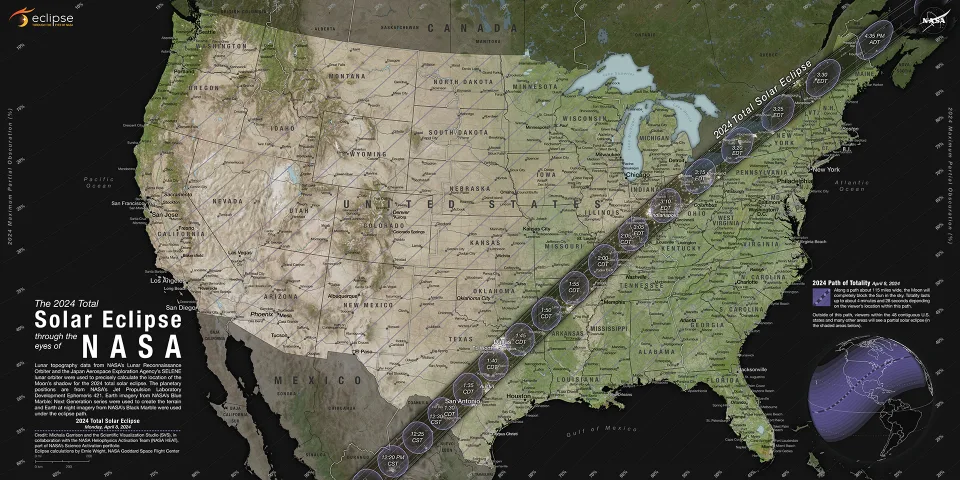On April 8, a solar eclipse will darken the skies. This is a rare astronomical event: The last North American total solar eclipse was on August 21, 2017, and there won’t be another on visible on the continent until 2044. The path of totality — where the sun will be fully blocked by the moon — covers over 30 million people in the US, Canada and Mexico.
The good news is that many major centers are in the 100-mile-wide band of totality, so millions of people will be able to see a full solar eclipse. It follows a northeast path, so Mexico’s Pacific coast will get the first views in Mazatlan starting at around 10:57 AM PDT (total eclipse starting at 12:07 PDT), followed by the city of Torreón (all times local).

The total eclipse moves into the United states at 12:10 PM CDT (Eagle Pass, Texas), then hits Austin, Fort Worth and Dallas — three out of five of the most populous Texas cities. From there, it moves into Little Rock, Arkansas, followed by select parts of Missouri, Illinois and Indiana (including Indianapolis).
Ohio cities Dayton, Toledo and Cleveland get the full show, followed by Erie, Pennsylvania, then Buffalo, Rochester and Syracuse in New York along with Maine. Canada is in on the fun too, with parts of southern Ontario (Hamilton, Niagara Falls) and Quebec (Montreal) getting the totality, along with New Brunswick, PEI and finally, Bonavista, Labrador at 4:03 PM NDT (Newfoundland Time).
If you’re elsewhere on the continent and can’t travel, know that the closer you are to the band of totality, the more the sun will be obscured by the moon (this map shows how much of the eclipse you’ll get depending where you are on the continent).
An impressive list of major centers are within 200 miles of totality, so they’ll get a 90 percent or better eclipse (Houston, St. Louis, Memphis, Nashville, Chicago, Cincinnati, Detroit, Toronto, New York, Boston).
Anyone in the US south, midwest and northeast should get a decent spectacle, as will folks in Canada’s southeast and Atlantic coast. Even if you’re not in those regions, you might still see (and can capture) a mini eclipse.
How long with the 2024 solar eclipse last?
From the beginning when the moon first starts to cover the sun (partial eclipse) until the end when the two bodies part ways is a good long time – up to two hours and forty minutes in Dallas, and 2:18 in Caribou, Maine.
However, totality itself is brief, with the duration dependent on how close you are to the center of the totality band and the time of day. It’s at just under four minutes in Dallas, less than three minutes in Presque Island, Maine and a mere minute and 12 seconds in Montreal.
What’s the weather forecast in area?
It’s still early for an accurate forecast, but a week is enough to get a general idea by region. Suffice to say, April isn’t the ideal month for clear skies. That said, an eclipse can still be visible through light cloud cover, and even if it’s thick, the sky will grow dramatically dark.
The odds of precipitation are indeed above average across most of the band of the eclipse. Forecasts predict that the chances for clear skies are better the farther northeast you live, the opposite of historical trends.
To wit, Dallas has showers forecast throughout the day (58 percent), which would mean continuous cloud cover and no clear view if that holds. That improves a bit when you get to Indianapolis (partly cloudy, 24 percent chance of rain), with things better still in Buffalo, New York (partly cloudy, 11 percent).
Things are looking good right now in Montreal, though, with mostly sunny skies and only a 9 percent chance of rain, and the same goes for Fredericton, New Brunswick.
Niagara Falls also figures to have decent weather during the eclipse (mostly sunny, 18 percent) and is in the path of totality, which has led to the city declaring a state of emergency out of caution. Officials estimate that a million people could pour into the area, creating potentially dangerous crowds.



